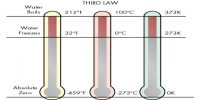The heat absorbed or evolved by a reaction depends on the conditions under which it occurs, such as pressure. Thus instead of the term “heat”, scientists prefer to refer to a related absolute property: Enthalpy. The symbol used for enthalpy is H.
Enthalpy and Enthalpy Change: When a reaction happens, reactants change into products. The reactants have a particular enthalpy (energy) and the products have a different enthalpy (energy). The difference between these two energies is the “heat of reaction or “enthalpy of the reaction° and typically ΔH = H products – H reactants.
Enthalpy H, Often, reactions take place in an open vessel, and therefore at the constant pressure of the atmosphere. The enthalpy change is equal to the heat energy change at constant pressure, qp i.e. ΔH = qp.
Strictly, H = U + PV where U = internal energy, P =Pressure, and V = Volume.
Enthalpy is an extensive property of substances (i.e. it depends on the amount of substance, as do mass and volume). It is a state function i.e. the value of any enthalpy change does not depend on how any change was made, but only on the initial and final state of the system.















